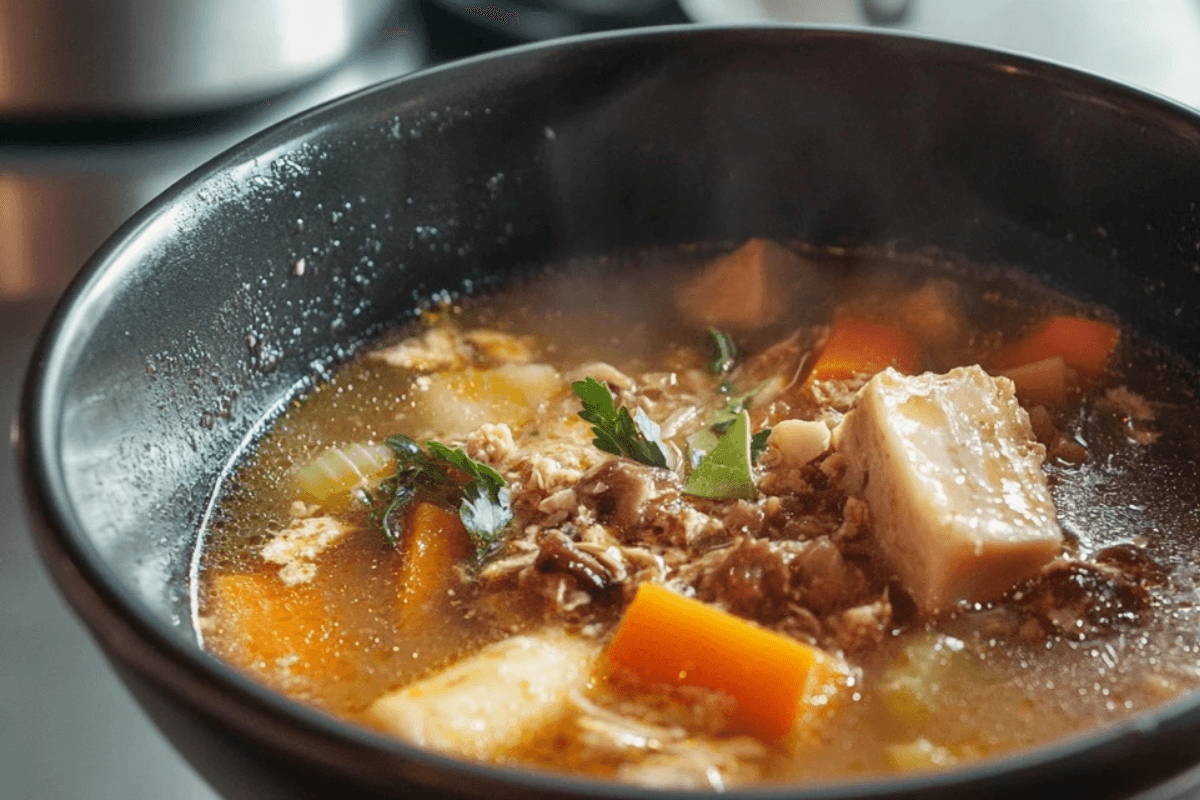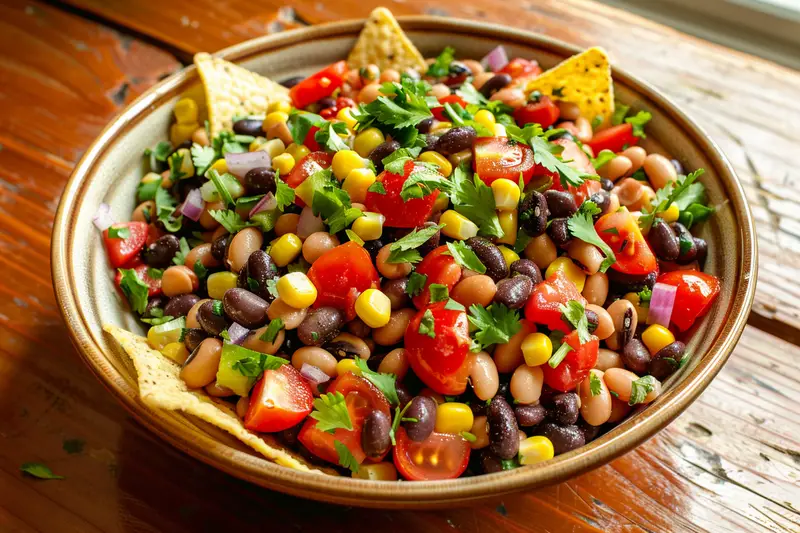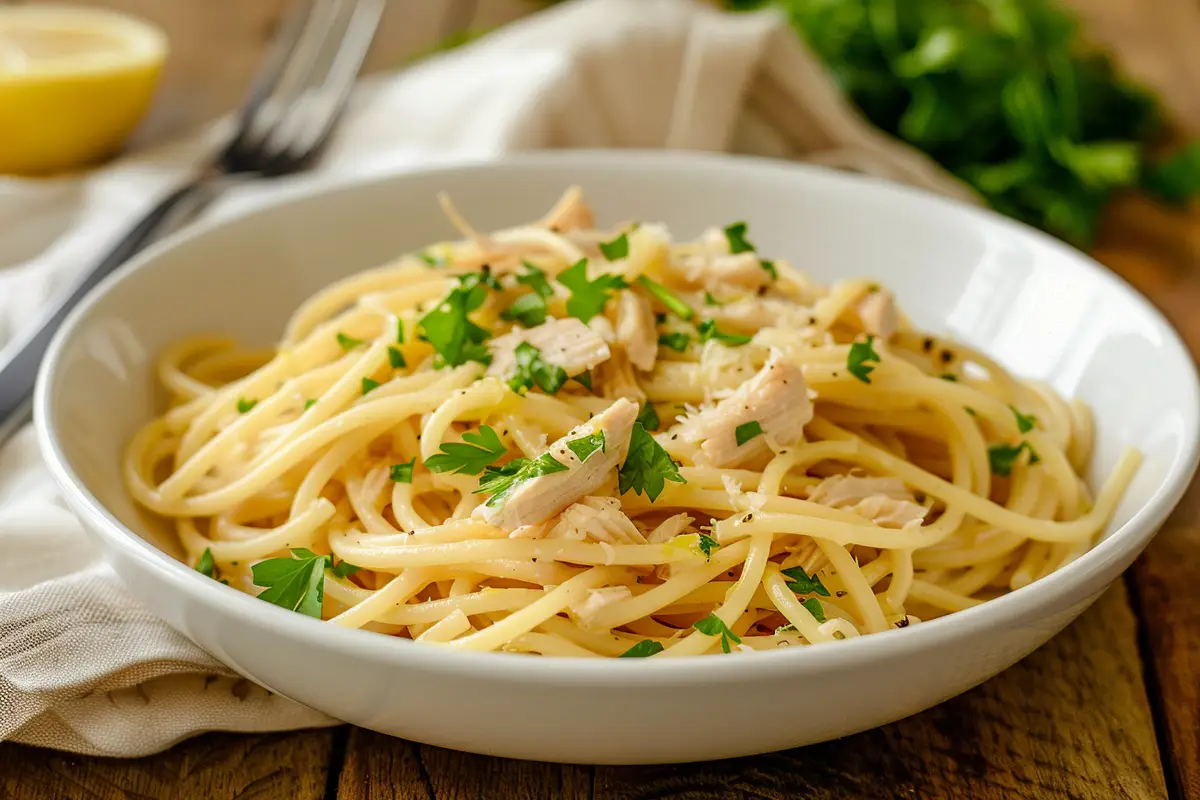Soup bones are more than just scraps left over from the butcher’s table—they are the secret to creating rich, flavorful, and nutrient-packed broths and stews. These unsung heroes of the culinary world are essential for anyone who loves hearty soups, comforting stews, or homemade bone broth. This guide dives deep into what soup bones are, their benefits, and how to make the most of them in your kitchen.
Whether you’re a seasoned chef or a home cook, understanding the versatility of soup bones can transform your cooking. Let’s explore the art and science behind using soup bones effectively.
Table of contents
What Is a Soup Bone?
Soup bones, commonly derived from beef, are bones with remnants of meat and connective tissue still attached. These often include knuckles, shanks, and neck bones. They release collagen, marrow, and minerals when simmered, creating a nutrient-rich and flavorful base for many dishes.
Characteristics of Soup Bones
- Bone Marrow: The rich, fatty tissue inside bones that adds a creamy texture and deep flavor to broths.
- Connective Tissue: Collagen in the tissue breaks down into gelatin, providing a silky texture in high-quality broths.
- Cuts of Beef: Soup bones typically come from lesser-used parts, such as knuckles and neck bones, which are perfect for long cooking.
Additionally, soup bones are incredibly economical and help reduce food waste. Using these often-overlooked cuts, you can create both budget-friendly and quality gourmet meals.
Learn more about creative ways to elevate your cooking with soup-based dishes in the Ultimate Guide to Taco Soup Frios.
What Is a Soup Bone in Slang?
Beyond the kitchen, “soup bone” has found its way into everyday slang. Historically, the term was often used humorously to describe skinny legs. In some regions, it is also used to refer to something undervalued but essential—a fitting metaphor for its role in cooking. While the slang meaning may vary, its cultural relevance highlights the enduring importance of soup bones.
Interestingly, soup bones also symbolize resourcefulness in many cultures. Their use reflects a tradition of making the most of every part of the animal, a practice rooted in sustainability and respect for resources.
Are Soup Bones Good to Eat?
Yes, and for more reasons than you might think! Soup bones are packed with nutrients that are released when simmered for extended periods. These nutrients not only enrich the broth but also provide several health benefits.
Health Benefits of Soup Bones
- Boosts Joint Health: Collagen and gelatin from soup bones support joint function and reduce inflammation.
- Strengthens Bones: Calcium, magnesium, and phosphorus in the marrow contribute to bone health.
- Supports Digestion: Gelatin soothes the gut lining and aids in digestion.
- Rich in Nutrients: Vitamins A and K, along with iron and fatty acids, make soup bones a nutritional powerhouse.
Moreover, soup bones are excellent for anyone on a paleo, keto, or nutrient-dense diet. Incorporating them into meals can elevate your health while adding unparalleled depth to your cooking.
Are Soup Bones Good for Dogs?
Soup bones can be an excellent treat for dogs, provided they are raw and appropriately prepared. Raw bones, especially knuckle bones, are both nutritious and beneficial for dental health. However, it’s critical to avoid giving cooked bones to dogs, as they can splinter and cause injuries.
How to Safely Give Soup Bones to Dogs
- Choose Raw Bones: Raw knuckles or marrow bones are ideal as they don’t splinter.
- Supervise Chewing: Always monitor your dog to ensure they’re chewing safely.
- Size Matters: Select bones large enough to prevent choking hazards.

Keep in mind that not all dogs will react the same to bones, so start with small portions to assess their tolerance. Always consult your veterinarian before introducing raw bones into your pet’s diet.
Cooking Soup Bones: Ingredients and Steps
Cooking soup bones requires patience and care to extract their full potential. Here’s a detailed guide to help you get started.
Ingredients Table
| Ingredient | Amount | Notes |
|---|---|---|
| Soup bones | 2-3 lbs | Use knuckle or marrow bones |
| Water | 12 cups | Enough to cover the bones |
| Vegetables | 2 cups | Carrots, celery, onions, or leeks |
| Apple cider vinegar | 2 tbsp | Helps extract minerals from bones |
| Garlic and fresh herbs | To taste | Adds depth and aroma |
Step-by-Step Instructions
- Roast the Bones: Preheat your oven to 400°F. Place the soup bones on a baking sheet and roast for 30 minutes. This step enhances their flavor and creates a deeper, richer broth.
- Prepare the Broth: Transfer the roasted bones to a stockpot or slow cooker. Add water, vinegar, and vegetables, fully submerging the bones.
- Simmer Slowly: Bring the mixture to a boil, then reduce to a low simmer. Cook for 12-24 hours for maximum flavor and nutrition.
- Add Herbs: During the last hour of cooking, add fresh herbs like parsley or thyme.
- Strain and Store: Remove the bones and strain the liquid into jars. Refrigerate overnight, and skim off the fat layer before use.
Tips for Success
- Use Low Heat: A gentle simmer prevents cloudiness in the broth.
- Don’t Rush: Long cooking times are essential for extracting nutrients.
- Freeze Leftovers: Broth can be frozen for up to three months.
Discover another comforting recipe idea in our Spicy Chicken Soup, perfect for any season.
Best Recipes Using Soup Bones
Soup bones shine in various recipes, from clear broths to hearty stews. Here are a few must-try dishes that highlight their versatility.
1. Classic Bone Broth
Rich, nourishing, and perfect as a base for soups or as a standalone drink, bone broth is a staple for good reason. Simmer soup bones with vegetables and herbs to create a delicious and nutrient-dense broth.
2. Hearty Beef Soup
Combine soup bones with chunks of beef, potatoes, and root vegetables for a comforting meal. This recipe is perfect for cold winter nights when you crave something warm and filling.
3. Vietnamese Pho
Pho’s signature flavor comes from simmering soup bones with spices like cinnamon, star anise, and ginger. For an unforgettable dish, serve with rice noodles, fresh herbs, and lime.
How to Make Soup Bones Step-by-Step
The process of making soup bones into a delicious broth doesn’t end with roasting and simmering. The steps that follow ensure your broth reaches its peak flavor and texture. Here’s how to complete the process like a pro.
Final Cooking Steps
- Strain the Broth: After simmering for 12-24 hours, remove the bones and vegetables from the pot. Use a fine mesh strainer to separate the liquid from any remaining solids. For an extra-clear broth, strain it through cheesecloth.
- Cool and Skim: Allow the strained broth to cool. Refrigerate overnight to let the fat rise to the top. Skim off this fat for a cleaner flavor, or save it for cooking.
- Season to Taste: Season the broth with salt and pepper before serving. Add a splash of soy sauce or fish sauce for an umami boost.
How to Use Soup Bone Broth
Once your broth is ready, the possibilities are endless. It can serve as the base for soups and stews or even as a warm, nourishing drink.
Popular Ways to Use Soup Bone Broth
- Soups and Stews: Add cooked meat, noodles, and vegetables to create hearty dishes.
- Sauces and Gravies: Use the broth as a base for rich, flavorful sauces.
- Cooking Grains: Enhance the flavor of rice, quinoa, or barley by cooking them in broth instead of water.
- As a Drink: Warm the broth, add a pinch of turmeric or ginger, and enjoy its soothing benefits.
Pro Tips and Variations
Cooking with soup bones can be as simple or creative as possible. Here are some tips to elevate your cooking and ideas for customizing your recipes.
Pro Tips
- Roasting Adds Flavor: Always roast your bones before simmering to bring out their natural flavors.
- Low and Slow: Keep the broth gently simmering to extract the maximum nutrients without clouding the liquid.
- Add Acid: Vinegar helps break down the bones, releasing more collagen and minerals.
- Experiment with Herbs: Add rosemary, thyme, or bay leaves to infuse unique flavors.
Creative Variations
- Spicy Twist: Add chili flakes, ginger, and garlic for a broth with a kick.
- Vegetarian Base: Swap bones for roasted vegetables like mushrooms, carrots, and onions to create a vegetarian-friendly alternative.
- Global Flavors: Incorporate spices like star anise, cinnamon, or cardamom for a pho-inspired broth.
Common Mistakes When Cooking Soup Bones
Even seasoned cooks can encounter challenges when making soup bone broth. Here are some common pitfalls and how to avoid them.
Mistakes to Avoid
- Using Boiling Water: Starting with boiling water instead of cold water can prevent proper extraction of nutrients and collagen.
- Skipping Roasting: Unroasted bones lack depth of flavor, resulting in a flat broth.
- Neglecting Skimming: Failing to skim impurities during simmering can lead to an overly greasy or cloudy broth.
- Short Cooking Times: For best results, allow the broth to simmer for at least 12 hours.
Customer Reviews and Feedback on Soup Bones
Understanding how others use and appreciate soup bones can help guide your own culinary journey. Customer reviews consistently highlight the quality, versatility, and flavor of soup bones, making them a top choice for home cooks and chefs alike.
What People Love About Soup Bones
- Flavor Enhancement: Reviews often mention how soup bones elevate dishes like vegetable stew and beef soup.
- Nutritional Benefits: Customers praise the richness of marrow and the health benefits of collagen.
- Ease of Use: Many users find soup bones easy to prepare, especially in a crock pot or pressure cooker.
One customer shared, “I couldn’t be happier with the results! The broth was silky, flavorful, and had just the right amount of marrow bone surrounded by meat.”
Marrow: The Hidden Treasure in Soup Bones
Marrow is the star of soup bones, providing not only flavor but also nutritional value. This fatty tissue, found inside beef bones, melts into broths and stews, creating a rich and creamy texture.
How to Maximize Marrow in Cooking
- Roast the Bones: Roasting marrow bones on a rimmed baking sheet intensifies their flavor.
- Use in Stews: Marrow pairs beautifully with hearty ingredients like beef shank and root vegetables.
- Enjoy as a Delicacy: Spread roasted marrow on toast for an indulgent treat.
Tip: Rinse the bones and pat dry with paper towels before roasting to ensure they brown evenly.
Beef Soup Bone: The Backbone of Great Soups
Beef soup bones are ideal for creating flavorful broths and meaty soups. They provide the foundation for dishes that are both comforting and satisfying.
Why Choose Beef Soup Bones?
- Rich Flavor: They release gelatin and collagen, enhancing the texture of beef stock.
- Versatility: Perfect for making a beef shank stew or a meaty soup base.
- Accessibility: Available in lb bags, making them an affordable option for home cooks.
When using beef soup bones, ensure there’s enough meat left on the bone for added depth of flavor.
The Perfect Roast: Bringing Out the Best in Soup Bones
Roasting soup bones is a critical step that enhances their natural flavors. The caramelization that occurs during roasting adds complexity to your broths and stews.

How to Roast Soup Bones
- Preheat your oven to high heat (400°F).
- Place the bones on a rimmed baking sheet and roast for 30 minutes.
- Turn the bones halfway through for even browning.
Pro Tip: Sear the roasted bones in a Dutch oven with garlic and onion for a richer soup base.
Stew Recipes Featuring Soup Bones
Stews are one of the most popular ways to use soup bones. These dishes are hearty, flavorful, and nutritious, making them a go-to comfort food.
Beef Shank Stew
Combine beef soup bones, beef shank, and tendon in a 6-quart stockpot for a robust, meaty soup. Add vegetables like carrots and celery, then simmer slowly for a dish that warms both the heart and soul.
Vegetable Stew with Marrow Bones
Soup bones pair perfectly with a variety of vegetables. Create a vegetable stew by adding potatoes, leeks, and tomatoes to the pot. Cover with water and let it simmer until all the flavors meld together.
Bone Marrow: A Nutrient-Packed Ingredient
Bone marrow isn’t just delicious—it’s incredibly nutritious. It’s packed with vitamins, minerals, and healthy fats, making it an excellent addition to any diet.
How to Use Bone Marrow
- Soups and Stews: Bone marrow adds a creamy texture to broth in a slow cooker.
- Standalone Dish: Roast the marrow and enjoy it as a side dish or appetizer.
- Gravy Base: Use marrow as the foundation for gravies and sauces.
Fun Fact: One of my favorite ways to use bone marrow is in casseroles, where it adds richness and depth.
Vegetable Stew: A Meat-Free Alternative
While soup bones are traditionally associated with meat-based dishes, they can also enhance vegetable stews. The bone gelatin adds a silky texture, making even meatless soups hearty and satisfying.
Vegetable Stew Recipe
- Ingredients: Use carrots, potatoes, and parsnips alongside stock bones for a rich broth.
- Preparation: Simmer all ingredients on a stovetop for 2-3 hours.
- Serving: Pair the stew with crusty bread for a complete meal.
Tip: If you’d like a lighter option, strain the broth and serve it as a soup base for future recipes.
Cooking Tools for Perfect Soup Bones
The right tools can make all the difference when working with soup bones. Here’s a breakdown of the essential equipment for home cooks.
Essential Tools
- Crock Pot: Ideal for hands-off cooking and long simmers.
- Dutch Oven: Perfect for roasting bones and making soups in one pot.
- Pressure Cooker: Speeds up the process while retaining flavor and nutrients.
- Stockpot: Great for making large batches of broth or stock.
Sourcing Quality Soup Bones
The quality of your soup bones matters. Here’s how to find the best options for your recipes.
Where to Buy Soup Bones
- Local Farm: Support sustainable farming practices by buying from local sources.
- Butcher Shop: Your butcher can provide cuts of meat that are ideal for soups and stews.
- Grocery Store: Many stores offer pre-packaged stock bones in lb bags.
Always choose bones like beef knuckles or shanks for maximum flavor. If you’re unsure, ask your butcher for recommendations.
FAQs About Soup Bones
How Do Soup Bones Create Great Soup?
Soup bones release gelatin and collagen during cooking, creating a rich, silky broth that serves as the base for many recipes.
What Are Stock Bones?
Stock bones are large, meaty bones used to make beef stock or broth. They are simmered for long periods to extract flavor and nutrients.
Can I Use Soup Bones for Dog Treats?
Yes, raw soup bones are excellent for dogs. They help clean teeth and provide nutrients. However, cooked bones should be avoided.
What is a Soup Bone?
A soup bone is a piece of bone with meat and connective tissue attached, typically from the knuckles, neck, or shanks of a cow. These bones are simmered to create nutrient-rich broths and flavorful soups.
What is a Soup Bone Slang?
The term “soup bone” is used as slang to describe skinny legs or to refer to something that is essential yet often overlooked metaphorically.
Are Soup Bones Good to Eat?
Yes, soup bones are highly nutritious. They release collagen, minerals, and healthy fats into the broth during cooking, making them a valuable dietary addition.
Are Soup Bones Good for Dogs?
Raw soup bones are safe and nutritious for dogs. However, cooked bones should be avoided as they can splinter and cause harm.
How Do You Store Soup Bones?
You can store unused soup bones in an airtight container or a freezer-safe bag. They can be frozen for up to six months without losing quality.
Can You Reuse Soup Bones?
Yes, soup bones can be reused to make broth. However, the second batch will be lighter in flavor and nutrients.
Conclusion
Soup bones are a culinary treasure, offering unmatched flavor and nutrition. Whether you’re creating a comforting soup, a hearty stew, or a simple broth to sip on, soup bones elevate every dish. By following the techniques and tips shared in this guide, you can maximize your potential and enjoy delicious, nourishing meals every time. Experiment with variations, avoid common mistakes and embrace the versatility of soup bones in your cooking. Happy cooking!
Want to see more? If you enjoyed this article, we invite you to join us on our Facebook page ElyseRecipes. That way, you’ll be among the first to hear about our updates, cooking tips, and recipe ideas! Come share your passion and connect with our community.
Print
Everything You Need to Know About Soup Bones
- Total Time: 12 hours 15 minutes to 24 hours 15 minutes
- Yield: 10–12 cups 1x
Description
Transform simple soup bones into a rich, flavorful bone broth with this easy recipe. Packed with nutrients, collagen, and minerals, this broth is perfect for sipping, as a soup base, or as a foundation for stews and sauces. Using roasted soup bones and fresh ingredients, this recipe is a staple for any home cook’s repertoire.
Ingredients
- 2–3 lbs soup bones (knuckle, marrow, or shank bones)
- 12 cups water (or enough to cover the bones)
- 2 cups vegetables (carrots, celery, onions, or leeks)
- 2 tbsp apple cider vinegar
- 3 cloves garlic (optional, for flavor)
- 2–3 sprigs fresh herbs (parsley, thyme, or bay leaves)
- 1 tsp salt (adjust to taste)
- 1 tsp black peppercorns
Instructions
Step 1: Roast the Bones
- Preheat your oven to 400°F (200°C).
- Place the soup bones on a baking sheet lined with parchment paper or foil.
- Roast the bones for 30–40 minutes, turning halfway through to ensure even browning.
Step 2: Prepare the Broth
- Transfer the roasted bones to a large stockpot, slow cooker, or pressure cooker.
- Add water, apple cider vinegar, and vegetables, ensuring the bones are fully submerged.
- Bring the mixture to a boil, then reduce the heat to a gentle simmer. Skim off any foam or impurities that rise to the surface.
Step 3: Simmer Slowly
- Simmer the broth for 12–24 hours for maximum flavor and nutrient extraction.
- If using a slow cooker, set it to low and cook for the same duration. For a pressure cooker, cook on high pressure for 2 hours, followed by natural pressure release.
Step 4: Add Herbs
- In the last hour of cooking, add fresh herbs, garlic, and peppercorns to infuse additional flavor.
Step 5: Strain and Store
- Remove the bones and vegetables from the pot. Strain the broth through a fine mesh strainer or cheesecloth into jars or containers.
- Allow the broth to cool completely before refrigerating. Skim off the fat layer that solidifies on the surface, or leave it for added richness.
Notes
- Freezing Tips: Freeze bone broth in portions using ice cube trays or freezer-safe containers for easy use in recipes.
- Flavor Boosters: Add a splash of soy sauce, fish sauce, or lemon juice before serving for extra depth of flavor.
- Reusable Bones: You can reuse soup bones for a lighter second batch of broth.
Variations:
- Spicy Kick: Add a few slices of fresh ginger, chili flakes, or star anise for an Asian-inspired broth.
- Vegetarian Alternative: Use roasted root vegetables, mushrooms, and herbs to create a vegetarian-friendly broth.
- Pho-Inspired: Add cinnamon, cloves, and coriander seeds to make a flavorful pho base.
- Prep Time: 15 min
- Cook Time: 12–24 hours (or 2 hours in a pressure cooker)
- Cuisine: Global
Nutrition
- Serving Size: 1 cup







